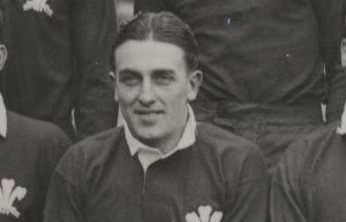Wales were England’s first opponents at Twickenham on 15 January, 1910. The home side won 11-6, thus ending a record run of 11 successive wins by Wales.
It was England’s first win against Wales since 1898 and their first try, by debutant wing Fred Chapman, came from the kick-off by Bridgend forward Ben Gronow and was scored before a Welshman had touched the ball:
“After the opening whistle, Wales kicked off towards the right touchline, with Adrian Stoop gathering the ball on the England “25” and fooling the Welsh defence when he decided to run rather than kick into touch. He put in a short kick, with the English forwards re-gathering and winning the ball from the ensuing maul before the scrum half Dai Gent sent John Birkett into a hole. Birkett took advantage of the disorganised Welsh defence to race through the middle before passing to teammate Fred Chapman as he came to the Welsh fullback Jack Bancroft. Chapman then outpaced the cover defence to score the first try at Twickenham, right from the kick-off. England went on to bury their twelve year losing streak against the Welsh, running out winners 11-6.”
It took Wales until 1933 before they notched their first win at Twickenham. At the 10th attempt they finally won 7-3 thanks to a try and drop goal from Cardiff wing Ronnie Boon. There was a championship record crowd of 64,000, in attendance at the game, including the Prince of Wales.

England led 3-0 at half-time with a try by fly half Walter Elliot, but within a minute of the second half starting, centre Ron Gerrard soccer-kicked straight into the hands of Boon who, in his usual cheeky manner, dropped a goal (then counting as four points) with three men outside him for a possible try!

At 4-3, it was Boon who clinched the win as Maurice Turnbull sent the ball along the line for Claude Davey to feed the Cardiff wing, who then raced round to the posts for a try. The Welsh touch-judge flagged the conversion kick by Viv Jenkins as over, but Irish referee Tom Bell ruled that the effort was wide.
Watcyn Thomas, the Swansea back-row forward, led Wales for the first time in a side that contained seven new caps, including three magnificent backs who were all to play cricket for Glamorgan; Viv Jenkins, Wilfred Wooller, Maurice Turnbull, who won an England test cap, but was killed in Normandy in 1944. It was said that Wooller’s tackle on the flying Elliot was alone worth the admission fee!
Harry Bowcott and Claude Davey were the ‘old hands’ who controlled splendidly and Iorrie Isaacs, who joined Leeds RL seven months afterwards, made a fine start, despite the first-turning up, first-packing down rule for forwards arriving at a scrum. Welsh-speaking, Pontarddulais-born Arthur Vaughan-Jones played in the England pack.
The first back-to-back victories came in the Grand Slam seasons of 1950 and 1952 and there was a further win in 1956 and a draw in 1958.
There were three draws in the Sixties – 1962, 1964 and 1968 – and a win in 1966. The Seventies saw Welsh victories in 1970, 1972, 1976 and 1978. Two wins in the Eighties – 1984 and 1988 – were followed by a 20 year drought before Warren Gatland arrived as head coach and won his first game in charge in 2008.
WATCH HIGHTLIGHTS OF 2008 WIN HERE
That was the first win in a Grand Slam campaign, while the victory in 2012 saw Sam Warburton’s Welsh side win the Triple Crown on English soil on their way to another Slam. That was the last championship win at Twickenham, although Wales did beat England in a World Cup game at the ground in 2015 – their last triumph in England.
Wales at Twickenham
| P | W | D | L | |
| Championship | 50 | 13 | 7 | 30 |
| Other Fixtures | 5 | 1 | 0 | 4 |
| Overall | 55 | 14 | 7 | 34 |
The Irish have the next best record at Twickenham in the championship – 12 wins and 3 draws – followed by the French with 10 wins and five draws and the Scots with 5 wins and 6 draws. Italy have yet to win at Twickenham.

